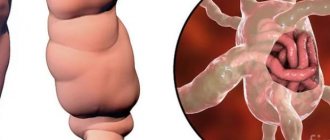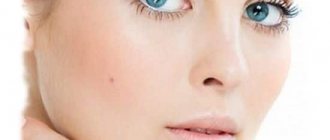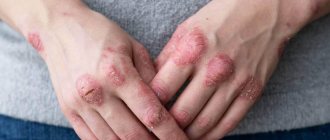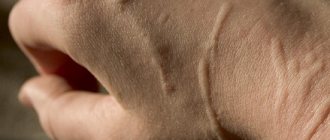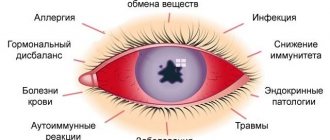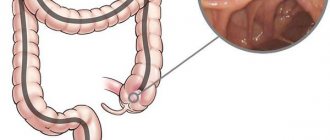Schamberg's disease (syn. Schamberg's purpura, hemosiderosis of the skin, chronic pigmentary purpura) is a chronic dermatological disease, against which the vascular wall of the capillaries localized in the skin is damaged, causing characteristic symptoms.
The mechanism and causes of the disease are currently unknown to specialists in the field of dermatology. A large number of clinicians believe that autoimmune processes act as a trigger.
The symptomatic picture is specific and includes the formation of pinpoint hemorrhages on the skin that form brown or purple spots. The rest of the clinic will be dictated by the course of the pathology.
Diagnosis is based on data obtained during a thorough physical examination and specially designed instrumental examinations. Laboratory tests are only of auxiliary value.
Treatment of Schamberg's disease comes down to the use of conservative therapeutic methods, but if they are unsuccessful, minimally invasive procedures are used.
Based on the International Classification of Diseases, Tenth Revision, it has been established that the disease has its own code. The ICD-10 code would be L95.8.
Causes of Schamberg's disease
The pathogenesis and sources of the disease have not yet been established, however, many specialists in the field of dermatology believe that the main provocateur of the disease is the occurrence of an autoimmune process in the human body. Against this background, what happens:
- increased permeability of capillary walls;
- intradermal petechial hemorrhage;
- release of hemoglobin from the vascular bed;
- conversion of iron into the pigment hemosiderin;
- the formation of spots on the skin with a specific shade.
Possible provocateurs include:
- diabetes;
- prolonged hypothermia of the body;
- chronic course of any infectious disease;
- fungal diseases;
- wearing low-quality winter clothing that does not cover the lower leg or foot - this leads to cold spasm of small blood vessels.
Classification
Chronic pigmentary purpura exists in the following forms:
- Petechial. In most situations, it is diagnosed in males. In such cases, the rash is localized only on the lower extremities. Externally they resemble spots that can have different sizes and shapes.
- Lichenoid. Pinpoint hemorrhages are evenly distributed throughout the body.
- Telangiectatic. The rash forms regularly shaped spots like a medallion. In the center of such a skin neoplasm, a pattern of damaged blood vessels is observed.
- Eczematous. Patients experience eczema-type rashes. This means that small bubbles form, and when they spontaneously burst, a crust appears.
Preventive measures
It is important to keep your skin clean, use only hypoallergenic skin creams and ointments, and carefully choose shoes and clothing during the cold season. Both hypothermia and overheating are harmful to the skin. You should limit heavy physical activity and avoid long walking and standing.
Equally important is a proper balanced diet and adequate intake of essential vitamins and minerals. You need to eat more fresh vegetables and fruits, avoid junk food, and don’t drink alcohol. You should try not to injure your lower limbs.
Symptoms of Schamberg's disease
Schamberg's disease in women and men begins with the occurrence of isolated pinpoint hemorrhages. As it progresses, the number of such points increases, and there is a tendency to merge into large spots. Over time, the old growths become lighter, and new brownish-purple areas form on top of them.
Against the background of the main clinical manifestation, the following are formed:
- severe skin itching;
- thinning and atrophy of the affected area of the skin;
- symmetrical arrangement of rashes - most often localized on the legs or thighs, and the areas of the upper extremities and torso are rarely involved in the pathological process;
- strengthening of the skin pattern along the edges of the spots;
- positive Koebner's sign - new rashes appear on top of the old rash;
- formation of a crust, which may have a yellowish or brown tint;
- an increase in the intensity of subcutaneous hemorrhages or the growth of spots - this is caused by trauma to the problem area.
It is noteworthy that there was no pain syndrome and the preservation of normal health. The person has no clinical signs of damage to any internal organ.
The nature of this disease
The nature of this disease has not yet been fully elucidated by medicine. It is believed to be an autoimmune disease. The immune system perceives capillary cells as an allergen and attacks them. The result of this is damage to the blood vessels and the release of a small amount of blood inside the skin.
It looks like a pinpoint hemorrhage. Subsequently, the iron contained in the blood is converted into hemosiderin, a pigment containing iron oxide. Because of this, the skin becomes brown in the area of the affected capillaries. Over time, new hemorrhages appear, having a bright color, while the old spots darken. The manifestation of the disease is called Schamberg's purpura. It is noted that this disease occurs more often in men than in women.
Diagnostics
There are no problems with establishing the correct diagnosis. This is due to the fact that Schamberg’s disease manifests itself with rather specific external signs.
Fundamental diagnostic measures:
- studying the medical history - to identify the most likely predisposing factor;
- collection and analysis of life history;
- assessment of the condition of the skin;
- palpation of problem areas;
- a detailed survey of the patient - to find out to what extent and for how long the main clinical signs have been expressed.
Instrumental procedures:
- dermatoscopy of rash areas;
- skin biopsy.
The most informative laboratory test consists of performing a general clinical and biochemical blood test: in some patients, pathology can provoke a change in blood composition.
One of the ways to establish the correct diagnosis is the desferal test, the essence of which is the intramuscular injection of 500 milligrams of Desferal. In the interval from 6 to 24 hours, urine is collected, in which the iron content is determined.
Schamberg's disease must be differentiated from the following pathologies:
- Kaposi's sarcoma;
- varicose type of dermatitis;
- other autoimmune processes;
- Bateman's purpura senile;
- Gougerot-Blum pigmentary dermatitis;
- Majorocchi's purpura annulare;
- oncological lesions of the skin.
In addition to the dermatologist, the following specialists take part in the diagnosis:
- vascular surgeon;
- endocrinologist;
- infectious disease specialist;
- immunologist;
- allergist.
Schamberg's disease treatment
Elimination of the disease is carried out using conservative therapeutic methods. For example, drug treatment involves:
- oral administration of non-steroidal anti-inflammatory drugs and angioprotectors;
- applying ointments and creams containing corticosteroids or heparin to problem areas of the skin;
- the use of potassium and calcium preparations - to strengthen the strength of the walls of blood vessels;
- the use of vitamin-mineral complexes, antihistamines and immunomodulators.
Patients are often prescribed:
- Detralex;
- Pentoxifylline;
- Diosmin;
- Antistax;
- Venozol;
- Hesperidin;
- Venarus;
- Troxevasin;
- Desloratadine;
- Venoruton;
- Cetirizine;
- Dexamethasone;
- Rutin;
- Vikasol;
- Ascorbic acid;
- Methylprednisolone;
- iron supplements.
Physiotherapeutic procedures:
- medicinal electrophoresis;
- ultrasound;
- phonophoresis;
- lymphatic drainage massage.
With Schamberg's disease, patients are advised to follow a gentle diet, which involves avoiding the consumption of allergens and irritating foods. The list of prohibited ingredients includes:
- citrus;
- chocolate and sweets;
- fried and spicy foods;
- smoked meats and canned food;
- homemade honey;
- alcoholic drinks;
- strong tea and coffee.
It is recommended to consume the following products in large quantities:
- tomatoes;
- carrot;
- pepper;
- pumpkin;
- cabbage;
- cucumbers;
- apples;
- grape;
- cherry;
- cherries;
- black currant;
- rose hip;
- viburnum;
- fermented milk products;
- green or herbal tea;
- dietary varieties of meat and fish;
- seafood;
- cereals;
- fresh greens.
The use of traditional medicine aimed at preparing medicinal decoctions for oral administration or as compresses at home is not prohibited.
Main components:
- mountain arnica;
- hazel bark;
- thick-leaved bergenia;
- horse chestnut
Such treatment must be agreed upon with the attending physician.
Severe pathology is treated with the following procedures:
- hemosorption or purification of blood from harmful products;
- plasmapheresis or purification of blood plasma;
- cryoapheresis - purification of plasma by cold.
Correction of the underlying disease, for example, diabetes, etc., is necessary.
Medicines used for skin hemosiderosis
- angioprotectors – substances that strengthen the elements of the vascular wall. The drugs mainly used are diosmin, hesperidin and their combinations. When choosing a specific drug, you need to focus on complex forms; the substance must be micronized, i.e. adapted for absorption in the human intestine. The standard course of angioprotectors should last at least 2 months;
- antihistamines can reduce the inflammatory element of the disease. This is most important in the eczematous type of Schamberg's disease. Cetirizine-based products are optimal for relieving skin allergies;
- drugs affecting immunity . In this case, consultation with an immunologist is necessary, because exactly how you need to act in your case is determined on the spot, based on the state of your body;
- treatment of concomitant diseases , associated infections (eczematous form) requires mandatory consultation with a dermatologist;
- restoration of blood counts with severe loss of hemoglobin. Iron supplements are prescribed. In case of disturbances in the natural reproduction of red blood cells, they stimulate the hematopoietic sprouts of the bone marrow. Several human erythropoietin preparations exist in this niche;
Prevention and prognosis
The reasons for the development of pathology remain a blank spot for clinicians, so there are no specific preventive measures.
You can reduce the risk of developing chronic pigmentary purpura by following these recommendations:
- maintaining a healthy and moderately active lifestyle;
- proper and balanced nutrition;
- avoiding hypothermia;
- constant strengthening of the immune system;
- complete treatment of diseases that can lead to pathology;
- Regularly undergoing a full preventive examination at the clinic.
The prognosis of Schamberg's disease is favorable - complex therapy and complete exclusion of the etiological factor lead to long-term remission. Complications develop extremely rarely.
If you think you have Schamberg's disease
and the symptoms characteristic of this disease, a dermatologist can help you.
Source
Did you like the article? Share with friends on social networks:
Diagnosis of the disease. How is it carried out? Should you see a doctor if you suspect this disease?
The diagnosis will be carried out by a dermatologist using dermatoscopy. This is a visual method of examining a skin sample under a microscope. In addition, the doctor will do a blood test for iron levels.
In some cases, a biopsy of liver and bone marrow tissue may be prescribed. The question arises about why there are so many tests and whether it is even worth seeing a doctor, because this disease does not bother you at all. Definitely, you need to see a doctor. And tests will help determine whether there are other diseases with symptoms similar to this disease. Prescribed medications and procedures will help reduce symptoms and slow down the appearance of new spots.
